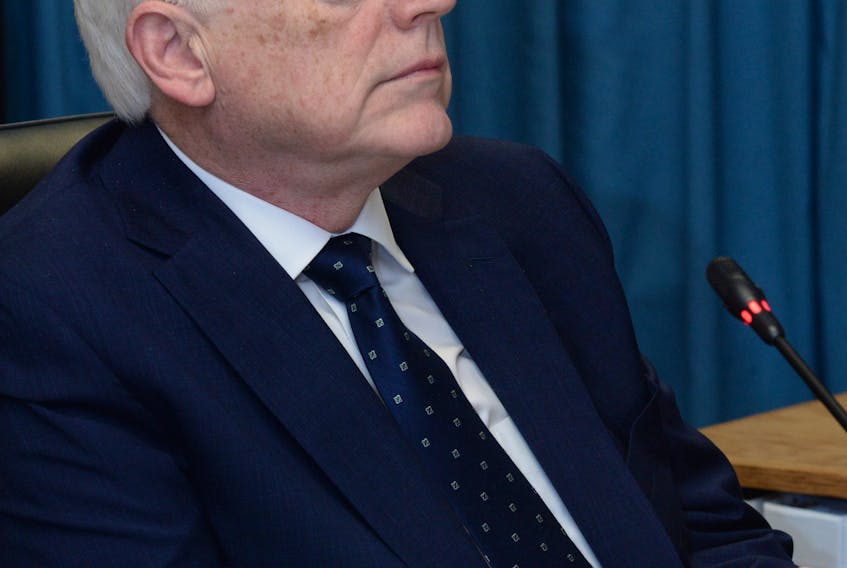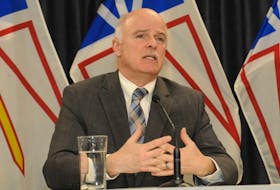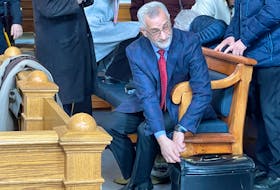Former Nalcor Energy president and CEO Ed Martin doesn’t recall communicating directly with the provincial government on exactly what kind of cost overrun the province could handle on the Muskrat Falls hydroelectric project.
“But when I say that, definitively, I don’t want to leave the impression that there wasn’t (communication),” Martin said Monday on the stand at the Muskrat Falls Inquiry.
“I know Derrick Sturge, my chief financial officer, he had extensive interaction with the Department of Finance. Other officials were involved with Natural Resources. So there would have been a lot of interaction on this."
— Ed Martin
The inquiry has heard lawyers suggest through questioning that the Government of Newfoundland and Labrador offered Nalcor Energy a “blank cheque” for the project. For example, former deputy finance minister Terry Paddon didn’t object to the term when it was used in his questioning in early November.
The inquiry has seen a line of government and Nalcor officials — including Paddon and Sturge — note the commitment of the province to cover cost overruns, locking in ratepayers and backstopping the project with the provincial coffers. But things are muddy when the questions turn to just how high overruns could go, how high they really might go if things did not go according to plan, and how they’d be covered.
Since the Muskrat Falls project’s approval, costs have skyrocketed beyond an estimate of $6.2-billion (not including financing), to reach its current $12.7-billion estimate (including financing costs and interest). The reasons behind the increase will be explored at the inquiry in 2019.
In questioning Martin, Inquiry co-counsel Kate O’Brien took him to a slide presentation of Newfoundland and Labrador Hydro from April 2006, and a slide titled, “NL Equity Contribution Advice.”
“Financial advisers indicate the province can borrow to provide an equity contribution of $2.0 - $2.5 billion without having a negative impact on the province’s credit rating,” she read from the Nalcor Energy subsidiary’s presentation. Then she asked Martin, “Do you know how that assessment was made?”
“No, I don’t,” he replied.
He was unable to say with certainty if the information came from the government. However, he said Nalcor Energy would typically interact with the provincial government on anything dealing with the province, as opposed to just what would land on the Crown corporation’s books.
O’Brien asked Martin if he was aware of any later assessments of what the Newfoundland and Labrador government would cover, before harming the province’s financial position.
“Well, I believe there would have had to have been (an assessment), is my first response. I’m not deep into the organization with these things, frankly. So I want to lay that out there first. This stuff has been delegated to Gilbert (Bennett, vice-president) and on down to handle,” he said.
Martin said he feels he would have checked to make sure the government was comfortable in what it was being asked for.
“But I can’t give you specific people, advice and interactions that were occurring,” he said.
When he was on the stand, Bennett testified he also didn’t know how high the province could go in covering costs arising.
“I know there were – there was further work done (after 2010). I don’t ever recall ever hearing a confirmation of what the limit would be,” he testified.
Sturge testified the province’s equity (in cash and borrowing) was a point of great discussion, reaching $3 billion as the thinking developed in 2009-10. But in response to a question from Tom Williams, he testified he generally would be “totally reliant on Finance” in assessing the province’s books and appetite for project risk and overruns. “We had no ability ourselves to assess that,” he said.
At Natural Resources, former deputy minister Charles Bown and former ministers Shawn Skinner and Jerome Kennedy indicated there was a reliance on Finance and consultants like MHI to review the numbers being provided by Nalcor, and on Nalcor to provide estimates accounting enough for risks — even if not all risk could be covered with mitigation efforts. Basically, the expectation was for accurate enough estimates, and execution of the project to plan.
Paddon said he expected amounts for risk to be included in the public cost estimate. He said he wasn’t aware of a quantification of risk completed in 2010, or further work by Westney Consulting ahead of the project’s sanctioning at the end of 2012. He said he wasn’t aware of any specific amount being recommended for a “management reserve,” and no one expected the project to go where it has.
“In our own minds, I think we were thinking in terms of, you know, maybe a $500 million kind of amount,” Paddon said of the potential cost overrun, unsure of where exactly the number came from.
Former finance minister Tom Marshall wasn’t aware of reports suggesting risk to be covered beyond what was in the project estimates. “I think any calculation for contingency or risk, any allowance or provision, would obviously be in the total estimate,” he said, while suggesting there was faith in the project estimates provided.
Martin continues on the stand through Friday.
Related stories:









